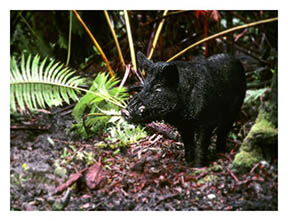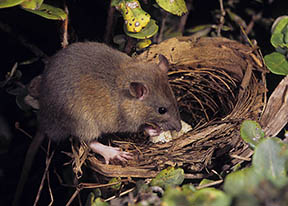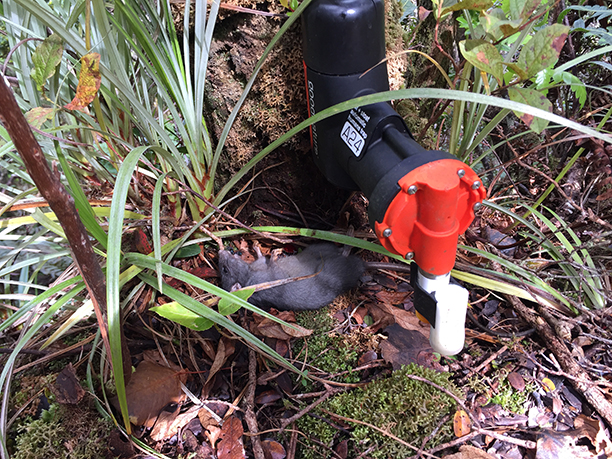Feral ungulates
A number of feral (i.e., formerly domesticated animals that have returned to the wild) ungulate species inhabit Kaua’i and all disrupt native ecosystems. Because Hawai’i has no native herbivorous mammals, the native plants did not evolve appropriate defenses, such as spines or thorns. Feral goats eat plants without discrimination, preventing the growth and regeneration of native forest. Feral pigs are a major threat to native birds and their habitat. Pigs destroy understory plants and prevent forest regeneration by forming a matrix of muddy trails, pulling up tree seedlings, ferns and other plants to eat their roots. Pigs dig wallows that fill with water and provide breeding habitat for mosquitoes (Culex quinquefasciatus), which spread deadly non-native avian diseases such as avian malaria to native birds. Last, pigs eat the fruits of invasive species such as strawberry guava and purple plague (Clidemia hirta) and defecate their seeds, serving to disperse these species throughout the forest.
Introduced predators
Three types of introduced predators affect native forest birds on Kaua’i. The most serious are introduced mammalian predators; because Hawai’i’s native forest birds did not evolve with mammalian predators, they have few natural defenses to these predators. Feral cats (Felis catus) are the most cryptic of these species. These stealthy hunters are known throughout the U.S. for preying on birds and Hawai’i’s native birds are no exception. Their presence is most often detected in native forests by the remains of prey and feces left behind on trails. Rats (Rattus norvegicus, R. exulans, and R. rattus) threaten native forest birds in two ways. One, they prey on nests, eating eggs, chicks, and incubating and brooding females. Second, they may compete with native birds for food resources, such as fruit and invertebrates that make up a large portion of the rat diet. Lastly, the introduced Barn Owl (Tyto alba) also likely threatens our native forest birds to some degree, by preying on adults and nestlings. To learn more about introduced mammalian predators in Hawai’i, this newsletter from the Conservation Council for Hawai’i is a great resource.
Non-native birds
Non-native birds (and some native birds) serve as disease reservoirs as they are able to carry avian malaria and pox. More than 170 species of birds have been introduced to the Hawaiian Archipelago since the arrival of humans, and fifty-four of those have established wild populations today. These birds have evolved resistance to the parasitic and viral pathogens that they brought with them when introduced to Hawai’i, and can act as carriers. Some species, such as the Japanese White-eye (Zosterope japonicus japonicas), Northern Cardinal (Cardinalis cardinalis), Japanese Bush Warbler (Cettia diphone), Melodious Laughing Thrush (Garrulax canorus), and White-rumped Shama (Copsychus malabaricus), have managed to establish populations in the high-elevation forests where they may compete with native birds for food and nesting habitat.




